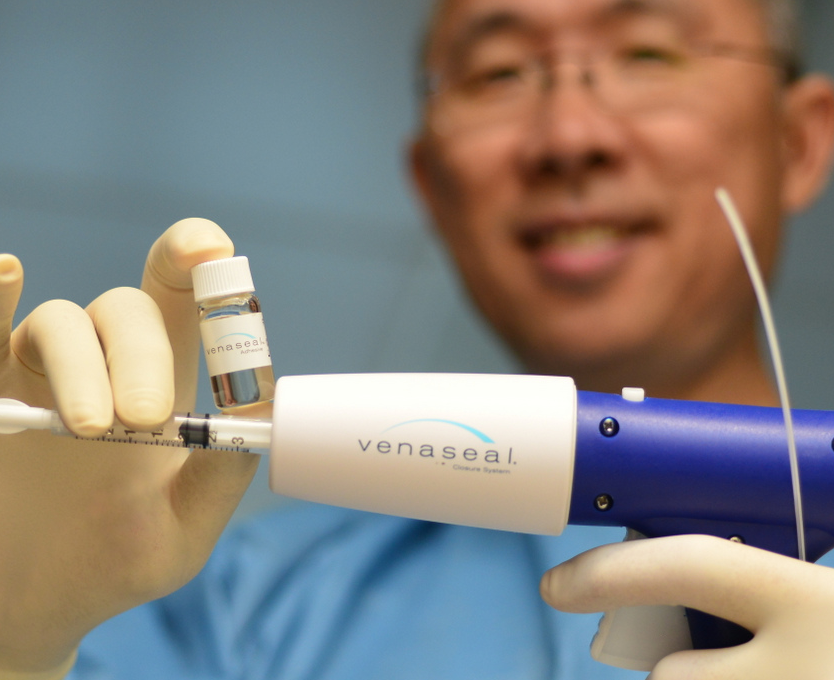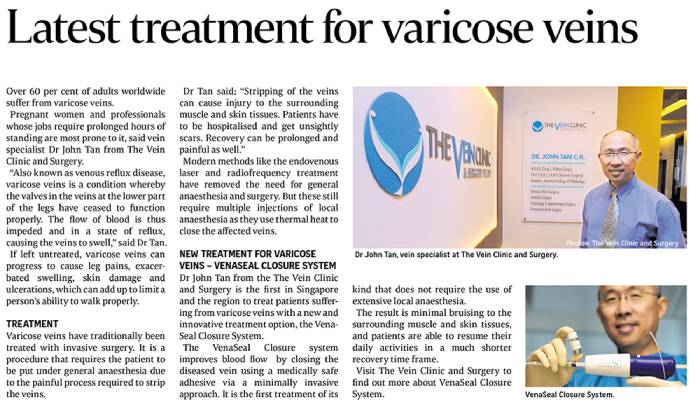The Vein Clinic is proud to be an early adopter in Singapore to perform Venaseal procedure for varicose veins. (read more)
- Home
- Venaseal
VENASEAL
What is Venaseal?
The VenaSeal™ closure system is the only non-tumescent, non-thermal, non-sclerosant procedure that uses a proprietary medical adhesive delivered endovenously to close the vein. This approach eliminates the risk of nerve injury when treating the small saphenous vein, which is a risk sometimes associated with certain thermal-based procedures.1,2 Clinical studies have demonstrated that the procedure is safe and effective.1-4 The procedure is administered without the use of tumescent anesthesia, avoiding patient discomfort associated with multiple needle sticks.

WHAT TO EXPECT
Before the VenaSeal ™ Closure Procedure:
You will have an ultrasound imaging exam of the leg that is to be treated. This exam is important for assessing the diseased superficial vein and planning the procedure.
During the Procedure:
You will have an ultrasound imaging exam of the leg that is to be treated. This exam is important for assessing the diseased superficial vein and planning the procedure.
- Your doctor can discuss the procedure with you. A brief summary of what to expect is below:
- You may feel some minor pain or stinging with a needle stick to numb the site where the doctor will access your vein.
- Once the area is numb, your doctor will insert the catheter (i.e., a small hollow tube) into your leg. You may feel some pressure from the placement of the catheter.
- The catheter will be placed in specific areas along the diseased vein to deliver small amounts of the medical adhesive. You may feel some mild sensation of pulling or tugging. Ultrasound will be used during the procedure to guide and position the catheter.
- After treatment, the catheter is removed and a bandage placed over the puncture site.
FAQ
How does VenaSeal work?
VenaSeal Glue is placed into the vein through a fine catheter and rapidly seals the vein shut.
Is loss of the vein a problem?
No. After treatment, the blood in the faulty veins will be diverted to the many normal veins in the leg.
Am I at risk from the VenaSeal Glue?
No. The glue has been trialed and tested in other areas of medicine for decades. It has been recently been the centre of large trials which show it be both safe and effective. The glue does not have any harmful effects to the body.
How successful is the VenaSeal Procedure?
Published clinical studies show that VenaSeal has an initial success rate of between 94% and 98.9% (6 months post treatment) with excellent long-term results. (The eScope study showed closure rate of 94.3% at 6 months and 92.9% at 12 months. The VeClose study showed closure rate of 98.9% at 6 months)
Are there any disadvantages compared to Laser?
- Unlike Laser and Radiofrequency which has been in use for > 10 years, Venaseal is a fairly new procedure; therefore there are no medium or long term data to prove its safety and efficacy.
- The glue used for this treatment does not get absorbed and remains in the body for long period.
- Slightly higher risk of getting phlebitis.
The Vein Clinic is proud to be an early adopter in Singapore to perform Venaseal procedure for varicose veins. (read more)
What is Venaseal?
The VenaSeal™ closure system is the only non-tumescent, non-thermal, non-sclerosant procedure that uses a proprietary medical adhesive delivered endovenously to close the vein. This approach eliminates the risk of nerve injury when treating the small saphenous vein, which is a risk sometimes associated with certain thermal-based procedures.1,2 Clinical studies have demonstrated that the procedure is safe and effective.1-4 The procedure is administered without the use of tumescent anesthesia, avoiding patient discomfort associated with multiple needle sticks.

What To Expect
Before the VenaSeal ™ Closure Procedure:
You will have an ultrasound imaging exam of the leg that is to be treated. This exam is important for assessing the diseased superficial vein and planning the procedure.
During the Procedure:
You will have an ultrasound imaging exam of the leg that is to be treated. This exam is important for assessing the diseased superficial vein and planning the procedure.
- Your doctor can discuss the procedure with you. A brief summary of what to expect is below:
- You may feel some minor pain or stinging with a needle stick to numb the site where the doctor will access your vein.
- Once the area is numb, your doctor will insert the catheter (i.e., a small hollow tube) into your leg. You may feel some pressure from the placement of the catheter.
- The catheter will be placed in specific areas along the diseased vein to deliver small amounts of the medical adhesive. You may feel some mild sensation of pulling or tugging. Ultrasound will be used during the procedure to guide and position the catheter.
- After treatment, the catheter is removed and a bandage placed over the puncture site.
FAQ
How does VenaSeal work?
VenaSeal Glue is placed into the vein through a fine catheter and rapidly seals the vein shut.
Is loss of the vein a problem?
No. After treatment, the blood in the faulty veins will be diverted to the many normal veins in the leg.
Am I at risk from the VenaSeal Glue?
No. The glue has been trialed and tested in other areas of medicine for decades. It has been recently been the centre of large trials which show it be both safe and effective. The glue does not have any harmful effects to the body.
How successful is the VenaSeal Procedure?
Published clinical studies show that VenaSeal has an initial success rate of between 94% and 98.9% (6 months post treatment) with excellent long-term results. (The eScope study showed closure rate of 94.3% at 6 months and 92.9% at 12 months. The VeClose study showed closure rate of 98.9% at 6 months)
Are there any disadvantages compared to Laser?
- Unlike Laser and Radiofrequency which has been in use for > 10 years, Venaseal is a fairly new procedure; therefore there are no medium or long term data to prove its safety and efficacy.
- The glue used for this treatment does not get absorbed and remains in the body for long period.
- Slightly higher risk of getting phlebitis.




